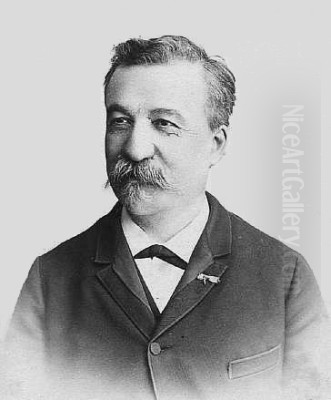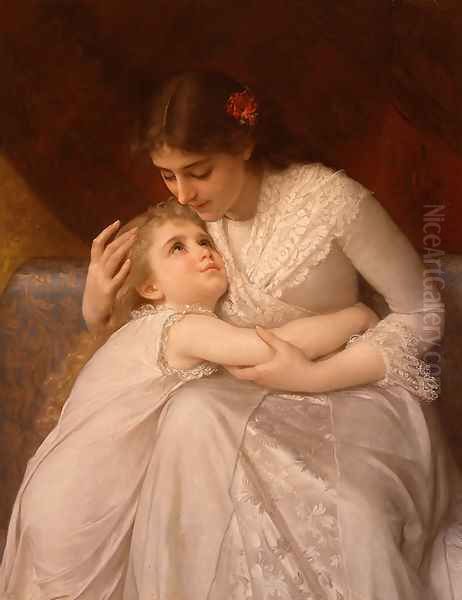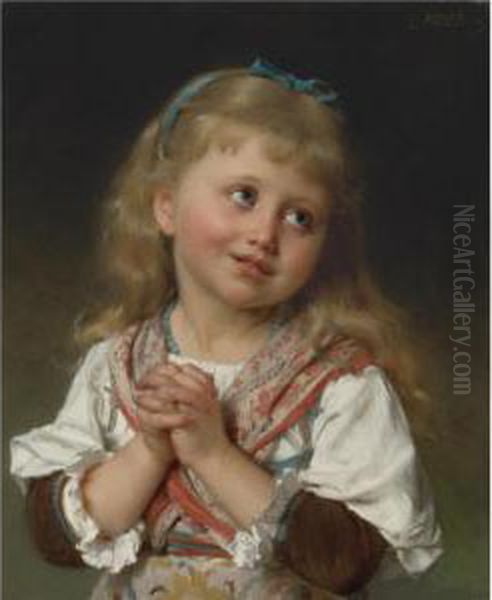Introduction: An Artist of Tender Moments

Emile Munier (1840-1895) stands as a significant figure within the French Academic tradition of the late nineteenth century. A contemporary of the burgeoning Impressionist movement, Munier chose a different path, dedicating his considerable technical skill to the creation of meticulously rendered, often sentimental depictions of domestic life, particularly focusing on the innocence and charm of children. As a devoted student and admirer of the renowned Academic master William-Adolphe Bouguereau, Munier absorbed the tenets of idealized beauty and polished technique, yet carved his own niche with subjects that resonated with warmth, tenderness, and familial affection. His work offers a window into the tastes and values of a segment of society during France's Third Republic, celebrating simple virtues and the perceived purity of youth in an era of rapid social and artistic change. While perhaps overshadowed by his famous mentor and the revolutionary modernists like Claude Monet and Pierre-Auguste Renoir, Munier's art retains a distinct appeal, cherished for its gentle spirit and exquisite craftsmanship.
Early Life and Artistic Foundations in Paris
Émile Munier was born in Paris on June 2, 1840, into a family connected to the world of decorative arts. His father, Pierre François Munier, was an upholsterer working at the historic Manufacture Nationale des Gobelins, the renowned state-run tapestry factory. His mother, Marie Louise Carpentier, worked as a polisher in a cashmere cloth mill. This environment, steeped in craftsmanship and design, likely provided an early exposure to artistic principles and meticulous execution. Young Emile demonstrated a natural aptitude for drawing, which his family encouraged.
His formal artistic training began appropriately at the Gobelins, where he studied drawing, painting, anatomy, perspective, and even the chemistry of wool dyeing under the tutelage of artists like Abel Lucas. This practical, craft-oriented education instilled in him a strong foundation in draughtsmanship and composition. Initially, Munier followed in the footsteps of applied arts, becoming a talented designer and decorator, contributing to the esteemed output of the Gobelins manufactory. This early phase honed his eye for detail and precision, qualities that would become hallmarks of his later easel painting.

However, the allure of fine art painting proved stronger than that of decorative design. While maintaining connections with the Gobelins community – notably through his relationship with his teacher Abel Lucas, whose daughter he would later marry – Munier began to shift his focus. He sought further instruction, aiming to master the techniques required for success within the highly competitive Parisian art world, dominated at the time by the Académie des Beaux-Arts and its official exhibition, the Paris Salon.
The Shadow and Light of Bouguereau
A pivotal moment in Munier's artistic development was his entry into the circle of William-Adolphe Bouguereau (1825-1905). Bouguereau was one of the most celebrated and influential painters of the era, a dominant figure at the Salon and a staunch defender of Academic principles against the rising tide of Realism and Impressionism. His work epitomized the Academic ideal: technically flawless execution, idealized figures often drawn from mythology or sentimental genre scenes, smooth surfaces devoid of visible brushstrokes (known as the 'fini'), and a strong emphasis on classical beauty and emotional restraint, albeit often tinged with sentimentality.
Munier became not just a student but a devoted follower and close friend of Bouguereau. The elder artist's influence on Munier's style is undeniable. Munier adopted Bouguereau's meticulous technique, his preference for idealized forms, particularly in the depiction of women and children, and his penchant for charming, easily accessible subject matter. Both artists excelled at rendering soft flesh tones, lustrous hair, and delicate fabrics with remarkable verisimilitude. They shared a common artistic language rooted in the classical tradition as interpreted by the French Academy.
Their relationship extended beyond the studio. Munier was a frequent visitor to Bouguereau's home and workshop, engaging in discussions about art and technique. Bouguereau held Munier in high regard, reportedly nicknaming him "le sage Munier" (the wise Munier), suggesting respect for his character and perhaps his thoughtful approach to his work. This close association provided Munier with invaluable guidance and likely opened doors within the established art world, reinforcing his commitment to the Academic style championed by his mentor and other leading figures like Jean-Léon Gérôme and Alexandre Cabanel.
Navigating the Salon System and Gaining Recognition
For an artist like Munier working within the Academic tradition, success was largely measured by acceptance and recognition at the official Paris Salon. This annual (or biennial) exhibition was the primary venue for artists to display their work, attract patrons, gain critical notice, and build their careers. Munier made his Salon debut in 1869, marking his formal entry into the professional art world as a painter rather than a designer.

His dedication and skill soon brought rewards. During the 1860s, even before his full transition to easel painting, his talent had been acknowledged with three medals from the École des Beaux-Arts, indicating early promise. Consistent participation in the Salon throughout the 1870s and 1880s solidified his reputation. He became known for his charming genre scenes, particularly those featuring children, which found favour with both the public and critics who appreciated traditional craftsmanship and appealing subject matter.
Beyond exhibiting, Munier also engaged in teaching, offering drawing classes. This was a common practice for established artists, providing a steady income and allowing them to pass on their knowledge. His teaching activities further integrated him into the Parisian artistic community. He successfully navigated the system, establishing himself as a respected, if not leading, figure within the Academic school, alongside contemporaries such as Jules Lefebvre and the highly successful historical painter Ernest Meissonier, though Munier's focus remained resolutely on more intimate, domestic themes.
The Essence of Munier's Style: Academic Precision and Sentimental Charm
Emile Munier's artistic style is firmly rooted in French Academic Classicism, characterized by meticulous draughtsmanship, a smooth, highly finished surface, and idealized representations of figures and settings. He possessed an exceptional technical facility, rendering textures – the softness of a child's skin, the fluffiness of a kitten's fur, the sheen of silk, the transparency of porcelain – with convincing realism. His compositions are carefully constructed, often employing stable, pyramidal arrangements or clear narrative structures that are easy to read.
Light plays a crucial role in his paintings. He often favoured bright, clear illumination, highlighting the central figures and creating a cheerful, optimistic atmosphere. His palette tends towards clean, bright colours, enhancing the sense of freshness and innocence, particularly in his depictions of children. While adhering to Academic principles of idealized beauty, Munier imbued his figures, especially the children, with a lifelike quality and individual charm. He excelled at capturing fleeting expressions – curiosity, mischief, concentration, affection – that brought his subjects to life.
His approach stands in contrast to the burgeoning movements of his time. Unlike the Realism of Gustave Courbet or Jean-François Millet, who often depicted the hardships of rural or working-class life with gritty honesty, Munier presented an idealized vision of domesticity and childhood. And while the Impressionists were exploring the fleeting effects of light and colour with broken brushwork and contemporary urban or landscape scenes, Munier remained committed to traditional techniques and sentimental genre subjects. His art aimed not to challenge or provoke, but to charm, soothe, and evoke feelings of tenderness and nostalgia.
Cherished Themes: Childhood, Domesticity, and Innocence
The heart of Emile Munier's oeuvre lies in his depictions of children. He returned to this theme repeatedly throughout his career, capturing infants, toddlers, and young boys and girls in moments of play, quiet contemplation, or interaction with pets and family members. These works resonated strongly with the sensibilities of the late 19th century, an era that often idealized childhood as a state of natural innocence and purity, a refuge from the complexities and perceived corruptions of the modern world.
Munier's children are typically portrayed as cherubic, healthy, and well-behaved, often engaged in simple, endearing activities: playing with kittens or puppies, learning a craft like knitting, sharing a secret, or offering a tentative apology. These scenes celebrate domestic virtues and the simple joys of family life. He frequently included pets, particularly cats and dogs, enhancing the charm and adding an element of playful interaction. The settings are usually comfortable, well-appointed interiors or idyllic garden spots, reinforcing the sense of security and contentment.
While children were his primary focus, Munier also painted portraits and scenes featuring young women, often embodying grace and maternal affection. His work occasionally touched upon mythological themes, such as depictions of Cupid, aligning him with the broader Academic interest in classical subjects, but his most characteristic and popular works remain his intimate portrayals of childhood. These paintings tapped into a widespread desire for images that were both aesthetically pleasing and emotionally reassuring.
Masterpieces of Innocence and Affection
Several paintings stand out as representative of Emile Munier's style and thematic concerns. Trois Amis (Three Friends) from 1885 is a quintessential Munier work. It depicts a charming young girl seated on a stool, flanked by a loyal dog and a playful cat, embodying the innocent bond between children and animals. The composition is balanced, the textures are exquisitely rendered, and the girl's expression is one of gentle affection. The work exemplifies Munier's ability to create a scene of pure, uncomplicated sweetness.
La Leçon de Tricoter (The Knitting Lesson), exhibited at the Salon of 1874, shows a young girl diligently focused on her knitting, perhaps under the watchful eye of an unseen mother or grandmother. This painting highlights themes of domestic skill, concentration, and the quiet virtues associated with traditional femininity. Munier reportedly created more than one version of this popular subject, including a notable copy sold at auction centuries later.
His later work, La jeune fille et le panier de chat (Girl with a Basket of Kittens), painted in the year of his death, 1895, shows his continued mastery of his preferred subject. A beautiful young girl gazes lovingly at a basket full of kittens, her pose and expression conveying tenderness and delight. The handling of light, the delicate rendering of the girl's features and dress, and the depiction of the soft fur of the kittens are all characteristic of Munier's mature style.
Other notable works include Favourite Kitten, Pardon, Mama, and variations on the theme of L'amour désarmé (Cupid Disarmed), a subject also famously treated by his mentor Bouguereau. These paintings consistently demonstrate Munier's technical polish and his focus on sentimental narratives, executed with a grace and charm that appealed widely to his audience.
A Life Reflected in Art: Family and Models
Emile Munier's personal life was intertwined with his artistic world. His first marriage was to Henriette Lucas, the daughter of his early teacher at the Gobelins, Abel Lucas. Tragically, Henriette died prematurely just a few months after the birth of their son, Emile Henri, in 1867, reportedly due to severe rheumatism. This personal loss may have deepened the artist's appreciation for the preciousness of life and family, themes often reflected in his work.
In 1872, Munier married Sargine Augrand (1837-1911), who was herself a talented painter and, like Munier, a student of Abel Lucas and a frequenter of Bouguereau's circle. This union brought stability and companionship, and Sargine became a supportive partner in his artistic life. They had one daughter, Marie-Louise, born in 1874.
His family members often served as models for his paintings. His son, Emile Henri, appears in some early works. However, it was his daughter, Marie-Louise, who became his most frequent and recognizable muse, appearing in numerous paintings throughout her childhood and adolescence. Her features can be seen in works like La Leçon de Tricoter and many others depicting young girls. This use of his own children as models likely contributed to the sense of intimacy and genuine affection that permeates his best work. His connection to fellow artists, like his wife Sargine and potentially others in Bouguereau's studio such as Elizabeth Jane Gardner Bouguereau (who also painted children and later married Bouguereau), placed him within a supportive network dedicated to Academic ideals.
Across the Atlantic: Patronage and International Appeal
While Munier enjoyed success in France, his work found a particularly receptive audience among American collectors during the Gilded Age. Wealthy Americans, seeking to emulate European aristocratic tastes and cultivate cultural refinement, were avid buyers of contemporary French Academic art. Munier's polished technique, charming subjects, and sentimental appeal aligned perfectly with the preferences of many American patrons.
Among his notable American clients were Chapman H. Hyams and his wife. Hyams, a prominent stockbroker and art collector from New Orleans, commissioned portraits from Munier and acquired several of his genre paintings. This connection proved lasting; a significant portion of the Hyams collection, including works by Munier, was later donated to the New Orleans Museum of Art, where they can still be seen today. This patronage highlights the transatlantic appeal of Munier's art and the broader taste for Academic painting in the United States during the late 19th and early 20th centuries. Other French Academic painters popular in America included artists like Pascal Dagnan-Bouveret, known for his scenes of peasant life rendered with photographic precision.
The popularity of Munier's images extended beyond elite collectors. His most charming compositions, particularly those featuring children and pets, were widely reproduced as prints, postcards, and other popular media, especially in the United States. This dissemination ensured his work reached a broad audience and cemented his reputation as a painter of delightful, accessible scenes, even as the critical tide in the art world began to turn decisively towards Modernism.
Munier's Place in the Tapestry of 19th-Century Art
Emile Munier occupies a specific place within the complex artistic landscape of the late 19th century. He was unequivocally an Academic painter, working within the tradition passed down through the École des Beaux-Arts and championed by figures like Bouguereau. His art prioritized technical skill, idealized beauty, and narrative clarity over the experimental approaches of his contemporaries in the Impressionist and Post-Impressionist movements, such as Edgar Degas or Vincent van Gogh.
He was not an innovator in the sense of challenging artistic conventions or forging new visual languages. Instead, he excelled within the established framework, demonstrating mastery of Academic techniques and applying them to subjects that resonated with popular sentiment. His focus on genre scenes, particularly involving children, places him in a lineage that includes earlier masters of intimate domesticity like Jean-Baptiste-Siméon Chardin, although Munier's style is distinctly of his own, more polished and sentimental era.
Compared to the grand historical or mythological canvases of Gérôme or Cabanel, or even the more varied output of Bouguereau, Munier's thematic range was relatively narrow. However, within his chosen specialty – the tender and charming depiction of childhood – he achieved a high degree of excellence and recognition. His work represents a significant aspect of late 19th-century taste, reflecting a desire for art that was beautiful, reassuring, and emotionally accessible. While Academic art fell out of critical favour for much of the 20th century, Munier's paintings, like those of Bouguereau, experienced a resurgence of interest among collectors and the public in later decades.
The Market for Charm: Auction Records and Value
The market value of Emile Munier's work reflects his position as a skilled but secondary figure within the Academic school, highly popular for his specific subject matter. While major works by his mentor Bouguereau can command prices in the millions of dollars, Munier's paintings generally trade at more modest levels, though exceptional examples can achieve significant sums.
A notable auction result occurred in September 2007 at Galerie Koller in Zurich, where a version (described as an "excellent replica" of his 1874 Salon painting) of Le Leçon de Tricot sold for 300,000 Swiss Francs (approximately $255,000 USD at the time). This price reflects the quality, appealing subject, and historical connection of the piece.
However, many of Munier's works, particularly smaller studies or less complex compositions, appear at auction with lower estimates. For instance, a small painting titled A Lady Holding a Rose (9 x 7 inches) was estimated at $400-$600 in a 2024 auction, indicating the wide range in market value depending on size, quality, subject matter, provenance, and condition. Works like Favourite Kitten and Trois Amis remain highly sought after by collectors specializing in this genre, valued for their quintessential Munier charm. The continued reproduction of his images also contributes to his name recognition, though it doesn't necessarily translate into high prices for all original works. His market reflects a niche appreciation for his specific brand of sentimental Academicism.
Enduring Legacy: An Artist of Innocence
Emile Munier died in Paris on June 29, 1895, at the age of 55. He left behind a body of work characterized by technical proficiency, delicate beauty, and a profound sympathy for his favourite subject: childhood. As a faithful student of Bouguereau and a respected member of the French Academic establishment, he embodied the virtues of traditional craftsmanship. While the avant-garde movements of his time ultimately reshaped the course of art history, Munier's paintings continued to find admirers, particularly among those who appreciated his gentle, idealized vision of domestic life and the universal appeal of youthful innocence.
His legacy is that of a specialist, a master of a particular kind of genre painting that charmed audiences in his own time and continues to resonate with many today. His works, found in museum collections like the New Orleans Museum of Art and numerous private collections, stand as testaments to his skill and to the enduring appeal of beautifully rendered scenes of tenderness and affection. Through his art, Emile Munier remains a cherished chronicler of childhood's fleeting grace.